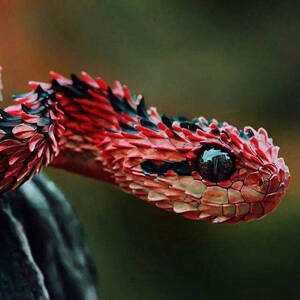Protobothrops cornutus
IUCN
LCBasic Information
Scientific classification
- name:Protobothrops cornutus
- Scientific Name:Protobothrops cornutus,Horned iron, horned pit viper
- Outline:Squamata
- Family:Viperidae Protoceratops
Vital signs
- length:70-90cm
- Weight:50-250g
- lifetime:No verification information
Feature
Head with a pair of horns
Distribution and Habitat
The distribution of the horned pit viper extends from Zhejiang, Fujian, Guangdong, Guangxi, and Guizhou in China to Vietnam, and the climate and species composition vary greatly between the distribution points.
Inhabits rocky habitats in limestone landforms
Appearance
The upper eyelids form a pair of horn-like protrusions that are tilted outward and covered with fine scales. The base of the horns is triangular cone-shaped; there is a dark brown "X"-shaped spot from the nose scales to the front of the base of the two horns; there is a pair of dark brown arc-shaped spots from the back of the horns to the back of the head; there is a light-colored thick stripe behind the eyes from the top of the mouth corner to the side of the throat, and below the light-colored stripe is a dark brown thick stripe. The back of the body is gray, gradually lightening towards the sides of the body, and there are dark brown square spots with gold edges arranged alternately from the neck to the tail. The belly scales are light gray-brown, with dark brown spots on both sides.
Details
The Latin name of the horned pit viper Protobothrops cornutus is very rare and its whereabouts in the wild are secretive.

The horned pit viper is a highly venomous snake. In addition to the common attributes of these venomous snakes, it also has its own unique "killer move". The fangs of the horned pit viper are very long, far exceeding the thickness of the head. The fangs of the horned pit viper are foldable and can be placed in the mouth when not in use, but once attacking, the fangs will open, just like a switchblade, with a white mist and extremely terrifying.
The venom of the horned pit viper is a neurotoxin & blood toxin. After being bitten, the wound is not very painful, but a little numb, but systemic symptoms will appear within a few hours, and the blood toxin will cause the wound to bleed continuously, skin necrosis, lymph node enlargement, difficulty breathing and eventually death from heart failure.
In addition to the fangs, the lancehead pits on both sides of the horned pit are not simple. They are organs that snakes use to sense infrared light. Human eyes can sense visible light from red to purple, but they are blind to infrared light. However, snakes can sense infrared light and can distinguish extremely subtle temperature differences to distinguish prey from the background. This allows the lancehead pit to attack prey even at night.
The horns on the head of the lancehead pit are erect thorn-like scales, which also have the function of luring enemies and camouflaging, making them look less like snakes. With the perfect camouflage color, they may lure prey into the trap and kill them with one strike.
Listed in the "National List of Terrestrial Wildlife with Important Economic and Scientific Research Value" issued by the State Forestry Administration of China on August 1, 2000.
Listed in the 2013 Red List of Endangered Species of the World Conservation Union (IUCN) ver3.1--Near Threatened (NT).
Listed in the China Biodiversity Red List-Vertebrate Volume, with an assessment level of Vulnerable (VU).
Listed in the second level of the "National Key Protected Wildlife List of China".
Protect wild animals and stop eating game.
Maintaining ecological balance is everyone's responsibility!








